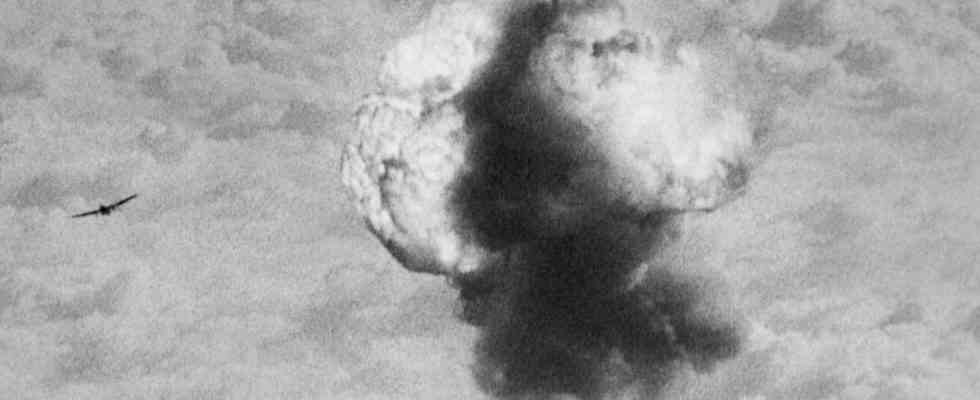The inferno can look terribly beautiful. A night air raid, filmed from one of the planes dropping the bombs, shows the detonations as flashes of light – the devastation appears as a mesmerizing spectacle and fireworks. Only the change to the ground reveals burning houses and fire-fighting crews who hardly stand a chance against the flames, disturbed people wandering around. And dead people lined up on the street.
The images of the documentary “Air War – The Natural History of Destruction” are old, they are film footage from the Second World War. The filmmaker Sergei Loznitsa collected material from various international archives, painstakingly restored it and reassembled it. The scenes are underlaid with a sophisticated sound design, there are no comments or subtitles. The recordings are not edited chronologically or assigned to the warring parties. Whether German planes are dropping their bombs over British cities or Allied bombs are falling on Germany is mostly impossible to tell.
This equal treatment is provocative, but one would hardly accuse Loznitsa of playing down Germany’s war guilt. He has dealt extensively with Nazi crimes in earlier films, for example in “Babi Yar. Context” from 2021, which reconstructs the massacre of over 30,000 Jews in the eponymous valley near Kiev. Or in “Austerlitz”, 2016, about mass tourism in the Dachau and Sachsenhausen memorials.
After the bombing: wounded women in Frankfurt am Main.
(Photo: Federal Archives/ Progress film distribution)
Loznitsa is Ukrainian but lives with his family in Berlin. Like “Austerlitz” before it, “Luftkrieg” was also inspired by texts by WG Seebald, which deal with coming to terms with the German past. In his book “Luftkrieg und Literatur” from 1999, the author and literary scholar Seebald dealt with the question of whether German literature adequately dealt with the carpet bombing of the Allies in World War II and the collective trauma of the German population. This sparked a heated debate.
One would like Loznitsa’s film to receive comparable attention. When the director started work on “Air War”, he could not possibly have known about Russia’s attack on Ukraine. Today “air war” seems red hot. Almost exactly a year ago, Russian bombs killed scores of civilians sheltering in the Mariupol theater. And “civilian infrastructure” is still being targeted, and blocks of flats, schools and hospitals are also being destroyed in Russian air raids. The fact that civilians always suffer in every war was only recently proven by the ghost towns in Syria.
The dramaturgy of “Luftkrieg” seems simple. Loznitsa briefly shows impressions of Germany before the war, which appears peaceful, almost idyllic. A man feeds pigeons, fishermen go about their work, followed by shots of a city in which swastikas can also be seen. After a devastating but rather distantly documented night of bombing, the film shows the logistics of the war and the armaments industry in great detail. Ultimately, the destruction of German cities in particular, but also British cities, was massive.
Archive recordings, especially in black and white and without comment, easily trigger signs of fatigue in viewers who are familiar with history TV. In “Luftkrieg” the repetitive horror is unnerving – the film itself is not. Some valuable documents can be seen, excellently restored and cleverly assembled into an essay.
Beyond the historical perspective and the current dismay, the film raises fundamental questions, such as the fascination with (war) technology that the armaments engineers of yesteryear could see, but which today inspires some debates about “leopards” or combat aircraft. Through his careful and detailed reconstruction of the armaments effort, it becomes clear what an effort, what level of inventiveness and engineering skill went into the war. Some of the best that man has to offer – in service of destruction.
Can war in general, and fighting a civilian population in particular, be justified at all? The fact that Loznitsa takes the fight against Nazi Germany as an example and above all shows Germans as victims provokes and productively complicates the answer to this question. In a speech, Churchill cynically shows the German population a “simple way” to protect themselves from British bombs: All they have to do is leave their cities and go to the country – and watch from afar as their houses burn.
The Natural History of Destruction – Germany, Netherlands, Lithuania 2022. Script directed by Sergei Loznitsa. Composition: Christiaan Verbeek. Sound design: Vladimir Golovnitsky. Editing: Danielius Kokanauskis. Distribution: Progress Film, 109 minutes. Theatrical release: March 16, 2023.

